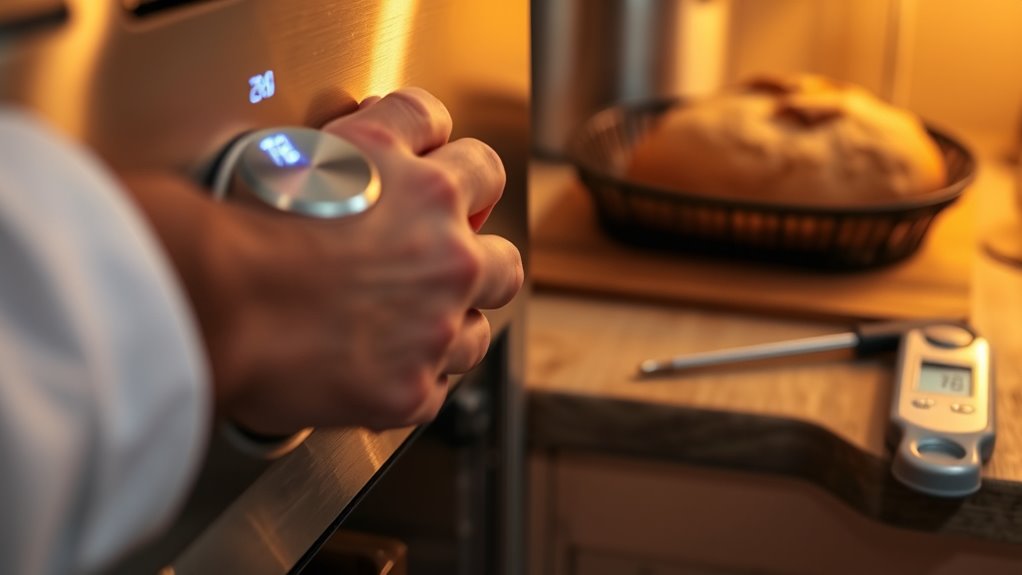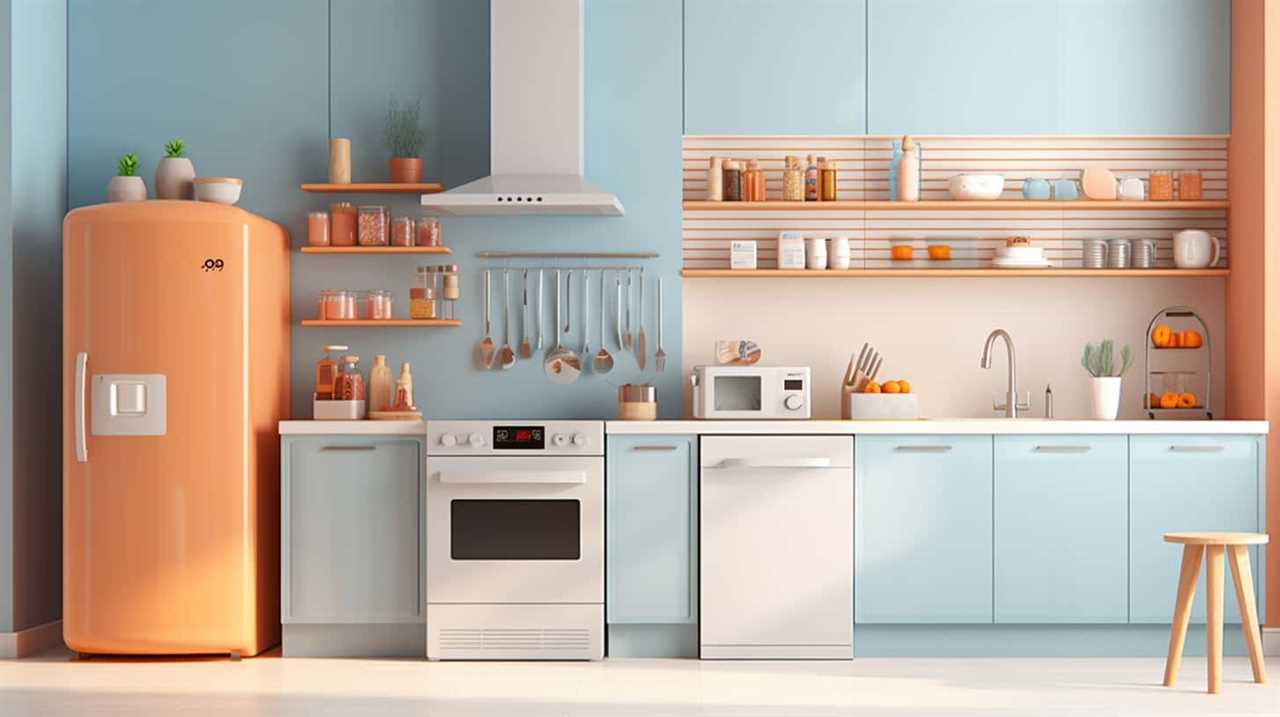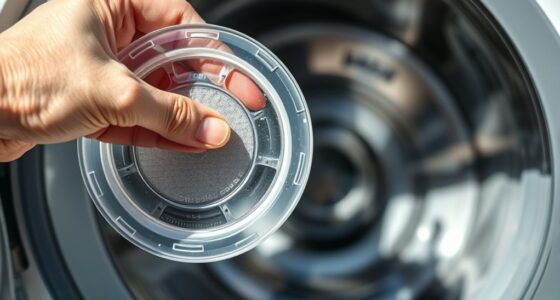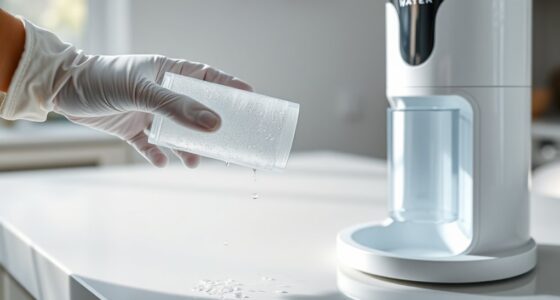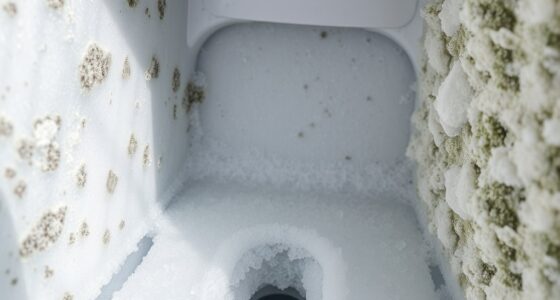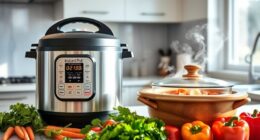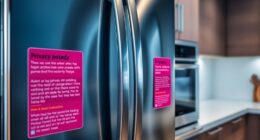To recalibrate your oven for accurate baking, start by placing an oven thermometer in the center and preheat to your usual temperature. Compare the thermometer to the oven dial—if there’s a difference, check your user manual for specific adjustment instructions. Make small tweaks, then recheck until the oven temperature matches the thermometer. Regular calibration guarantees consistent results; keep exploring to find detailed steps tailored to your oven model.
Key Takeaways
- Use an oven thermometer placed in the center to check actual temperature against the dial.
- Preheat the oven for 15-20 minutes before taking a temperature reading.
- Consult your oven’s manual for specific calibration instructions or adjustment methods.
- Make gradual adjustments via calibration screws or buttons, then recheck with the thermometer.
- Perform regular temperature checks and recalibrate periodically to ensure consistent baking results.
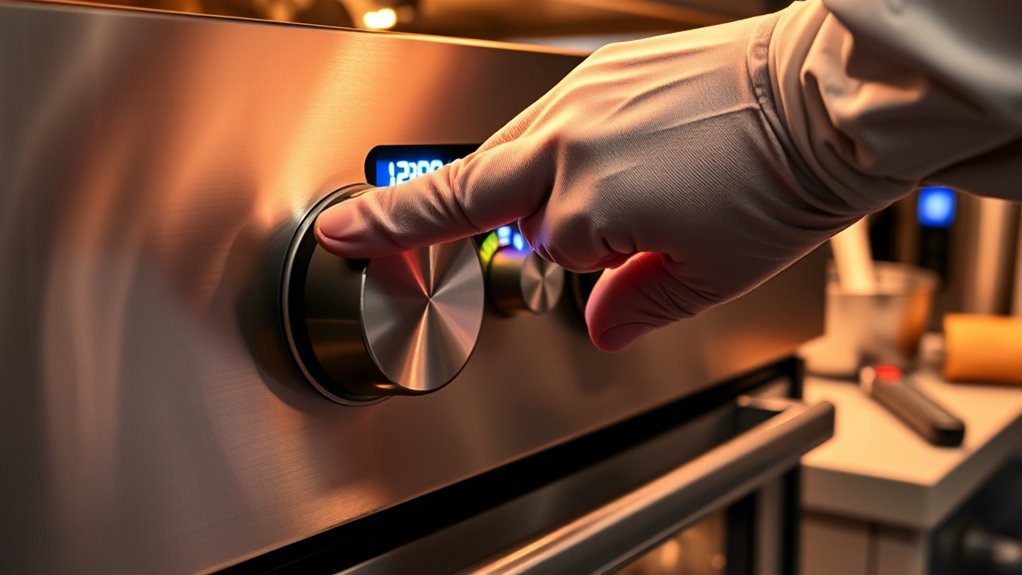
If your baked goods aren’t turning out as expected, your oven’s temperature might be off. Many home ovens tend to drift from their set temperatures over time, which can lead to uneven baking or consistently under- or over-cooked items. To verify your oven is operating accurately, you need to check its temperature with an oven thermometer. This simple device provides a real-time reading of the actual internal temperature, allowing you to see if your oven is running hotter or cooler than what the dial indicates. Once you have the thermometer in place and note the discrepancy, you can proceed with a temperature adjustment to correct any inconsistencies.
Using an oven thermometer is straightforward. Place it in the center of your oven, turn the oven on to the temperature you usually bake at, and wait for about 15-20 minutes for the oven to heat fully. Check the thermometer reading against the oven’s dial. If the thermometer shows a considerably different temperature from what you set, it’s time to recalibrate your oven. Many ovens have a way to adjust the temperature settings, either through a calibration function or by manually adjusting the temperature dial. Consult your oven’s user manual for specific instructions on how to do this, as procedures vary by model. In some cases, you might need to turn a calibration screw or press a sequence of buttons to access the adjustment mode. When making a temperature adjustment, do so gradually, and then recheck with your oven thermometer to see if the correction was successful. Additionally, understanding oven calibration can help you maintain consistent baking results over time.
Frequently Asked Questions
How Often Should I Recalibrate My Oven?
You should recalibrate your oven at least once a year to guarantee oven safety and baking accuracy. Use calibration tools like an oven thermometer to check if the displayed temperature matches the actual heat. If you notice uneven baking or inconsistent results, recalibrate more often. Regular calibration helps prevent accidents and keeps your oven functioning properly, so make it part of your routine maintenance for the best baking outcomes.
Can I Recalibrate Without Professional Tools?
Did you know that 60% of home ovens are off by at least 10 degrees? You can definitely DIY calibration using oven thermometers. First, place the thermometer inside, set your oven to 350°F, and compare the readings. If there’s a discrepancy, adjust the oven’s thermostat if possible, or note the difference for future baking. No professional tools needed—just a reliable oven thermometer and a little patience.
Will Recalibrating Affect My Oven’s Warranty?
Recalibrating your oven might affect your warranty implications, so check your warranty terms first. If you do it yourself, it’s usually considered a user adjustment and shouldn’t void the warranty unless the manufacturer specifies otherwise. However, if a professional performs oven calibration, it’s less likely to impact your warranty. Always review your warranty policy before making adjustments to avoid any unintended issues.
How Do I Know if My Oven Is Already Accurate?
You can tell if your oven is already accurate by performing a simple temperature testing. Use an oven thermometer and place it inside, then set your oven to a specific temperature, like 350°F. After the oven heats up, check if the thermometer matches the display. If it’s off, your oven might need calibration. Regular oven calibration guarantees consistent baking results and maintains precise temperature readings.
Are Digital and Analog Ovens Recalibrated Differently?
Digital and analog ovens are recalibrated differently due to their control systems. For digital ovens, you typically access calibration procedures through the digital display menu, following specific instructions to adjust temperature settings. Analog ovens might require manual adjustments, such as turning calibration screws or knobs. Always consult your oven’s manual for precise calibration steps, ensuring accurate temperature readings and consistent baking results.
Conclusion
Recalibrating your oven is like tuning a musical instrument—you’ll guarantee every bake hits the perfect note. By taking a few simple steps, you transform your oven from a temperamental artist into a reliable chef’s partner. Don’t let inaccurate temperatures throw off your baking rhythm; instead, keep your oven in harmony. With a little effort, you’ll enjoy consistently flawless treats that sing with flavor—making your kitchen the stage for delicious success.
